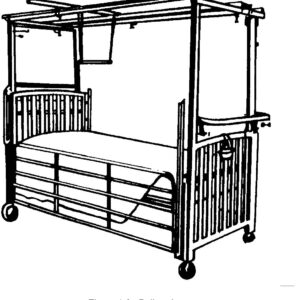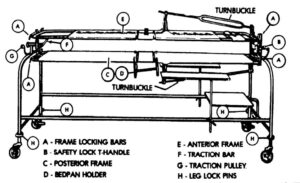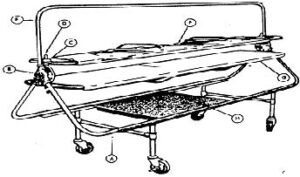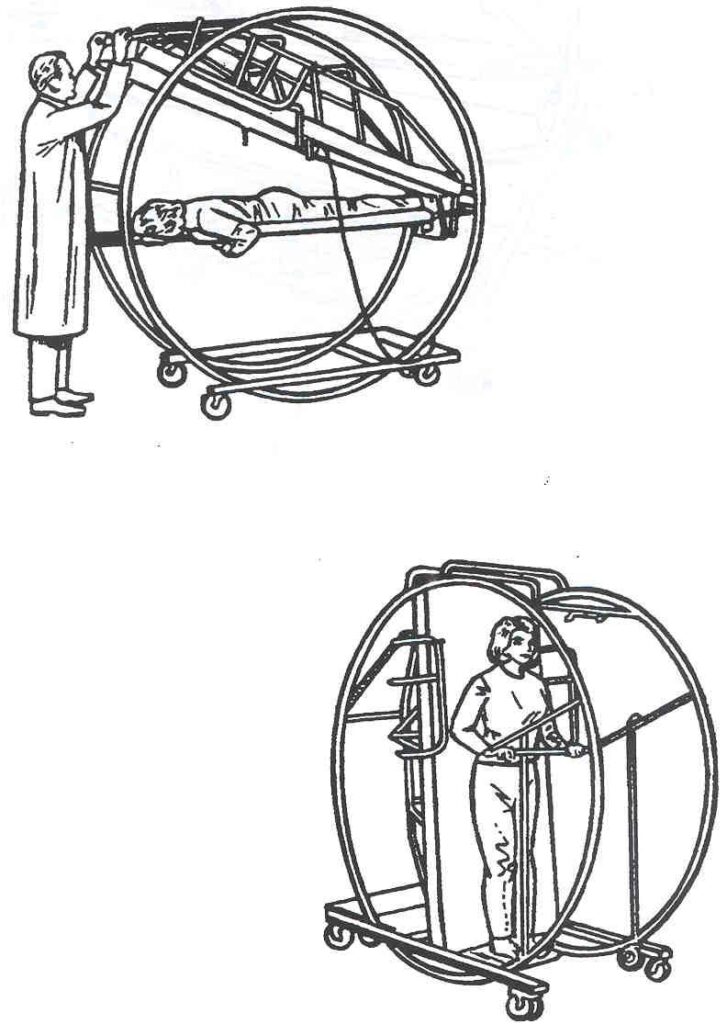1-8. THE ORTHOPEDIC BED
a. The basic orthopedic bed is a standard hospital bed with a firm mattress. A slatted orthopedic bedboard may often be placed under the mattress for extra support.
b. The basic orthopedic bed often requires an over bed frame to accommodate any traction or suspension system that may be required. The framework is inserted into or clamped to the corners or ends of the hospital bed. The frame allows the utilization of adjustable pulleys, slings, harnesses, clamps, and other attachments. The Balkan frame, illustrated in figure 1-2, is one example of an over bed frame. The Balkan frame is standard equipment in US Army patient care facilities, but other types of equipment are used as well.

c. The trapeze is an attachment that is used to assist the patient in movement during activities of daily living. Bathing, linen changes, bedpan use, and repositioning are made easier with the use of the trapeze. The trapeze is grasped firmly with the hands and a “pull-up” movement lifts the upper body and buttocks from the bed. The patient may use an unaffected leg for assistance by flexing the knee, placing the foot flat on the mattress, and pushing down on the bed while pulling straight up on the trapeze.
1-9. SPECIAL ORTHOPEDIC BEDS–TURNING FRAMES
a. Turning frames are devices used to provide immobilization and to facilitate nursing care for the patient who, while immobilized, requires frequent repositioning from supine to prone. In addition to its orthopedic applications, a turning frame is used in the treatment of patients with such conditions as spinal cord injuries and severe burns.
b. The major advantage in the use of turning frames is the prevention of the complications given below.
(1) Pressure sores. With relief of pressure from body weight on bony prominence and pressure areas, blood supply is improved. Additionally, large body areas may be exposed for skin care.
(2) Respiratory congestion. Rotation of the patient from face-up to face-down aids in loosening and ridding the lungs of fluid accumulation. The patient can cough and expectorate more effectively in the prone position.
(3) Kidney and bladder complications. Rotation of the patient aids in elimination of urine sediments that are potential causes of kidney stones.
c. Nursing management of a patient in a turning frame is the same as for any other immobilized patient. The nature of the care required depends upon the reason for immobilization (casts, traction, paralysis, and so forth). Nursing care of the immobilized orthopedic patient is discussed later in this lesson in Sections V and VI.
1-10. TYPES OF TURNING FRAMES
a. Double Frames. The Foster reversible orthopedic bed (see figure 1-3) and the Stryker turning frame (see figure 1-4) are commonly used.


Both are double frames, which are rotated on the longitudinal (side-to-side) axis. The operation of both is similar in principle, with variations in the details of preparation for use. Both have a rotary-bearing turning apparatus at each end, which allows traction to be maintained during the turning process. The patient is “sandwiched” between two canvas-covered frames when he is turned. The anterior frame, on which the patient lies prone, is constructed of either two pieces of canvas or one piece of canvas with a perineal cutout. The posterior frame, on which the patient lies supine, is constructed with two pieces of canvas that have an open space between them for the buttocks. A canvas buttocks strap is used between the two sections to keep the buttocks from sagging. This strap is removed only for skin care or bedpan use.
b. Improvised Litter Frames. Two canvas litters, padded with blankets, may be used as anterior and posterior frames when commercially manufactured frames are not available. The frames are placed on sawhorses for greater stability, but may also be used with standard litter brackets. Litter straps are used to bind the two frames together for turning.
c. Circo-Electric Beds. A circo-electric bed (see figure 1-5) is an electrically powered apparatus, which can be used as a turning frame for vertical (end-over-end) rotation. It can also be utilized as a tilt table and for unrestricted gatch positioning.

